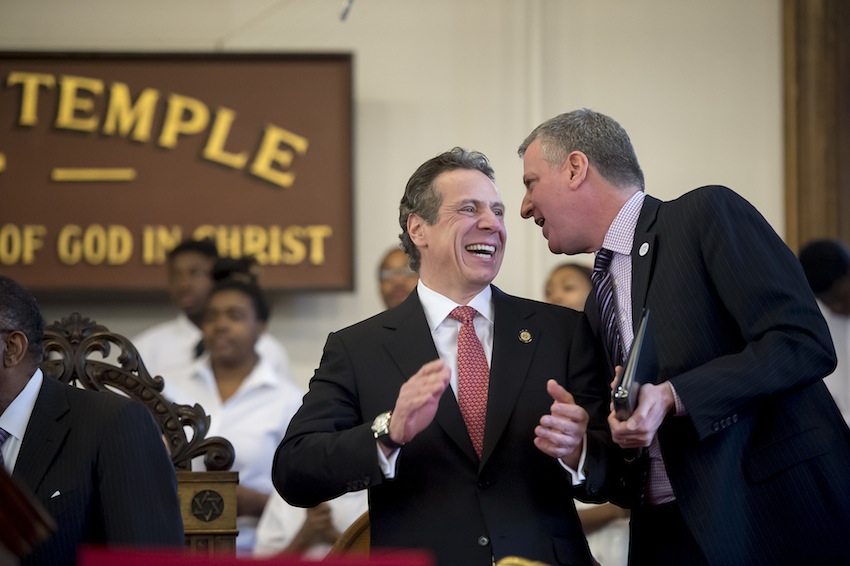
Rob Bennett for the Office of Mayor Bill de Blasio
Gov. Cuomo and Mayor de Blasio at the Wilborn Temple First Church Of God In Christ in Albany on Sunday, February 16, 2014.
On Election Night 20 years ago, I managed to sneak with a group of other fresh-faced College Democrats into the ballroom at the Sheraton to witness the end of Mario Cuomo’s political career and the nationwide Republican revolution. Last night, a younger Cuomo coasted to victory amid another broad Republican wave, which swept into the state Senate as well.
If I’ve learned one thing in the past two decades, it’s that a light blue double-breasted blazer does not make you look like a sophisticated political insider. If I’ve learned another thing, it is that the morning of the day after an election is a common time to think a beautiful new day has dawned—remember the dancing in the streets after Election Day 2008?—or that a nightmare has descended upon us.
The afternoon of the day after an election, however, is a good time to take a step back and, if you’re a progressive, wrap yourself in this cold comfort: It’s not that much worse than it already was.
Republican control of the state Senate certainly is not great news for Mayor de Blasio, his affordable housing plan or rent-stabilized tenants in the city, and all for the same reason: The biggest thing on the legislature’s plate next year is the renewal of rent regulations on nearly 1 million apartments in the city. They’ll also deal with the 421a tax break and other key elements of housing policy in the city. All of it will bear significantly on the mayor’s ambition to build or preserve 200,000 units of housing, and the housing plan in turn is critical to de Blasio’s overall effort to reduce inequality.
The fact is, however, strengthening the regulations on rent-stabilized apartments—which is what de Blasio and his allies want and need to do—was always going to be a very tough lift, even if the State Senate had stayed the way it was or if Democrats had even increased their edge slightly.
The Senate that was elected in 2012 had 33 Democrats and 30 Republicans. Each party eventually vacated one seat, theoretically giving the Dems a 32-29 edge. But Democrat Simcha Felder decided to caucus with Republicans, reducing it to a 31-30 Democratic advantage. And then there was the breakaway Independent Democratic Caucus, with five members, which opted to share power with the GOP. Score it 26-30+5. Plus, two Democrats—Malcolm Smith and John Sampson—were excommunicated by their party conference after corruption allegations emerged. So the composition going into election day was …
24 Democrats in caucus
2 Democrats not in any caucus
5 Democrats in the Independent Democratic Caucus
1 Democrat caucusing with Republicans
29 Republicans
2 vacant seats
Last night, each party reclaimed the seat that was vacant, Smith didn’t run and was replaced, Sampson ran and won, Felder was re-elected and Brooklyn’s Jesse Hamilton, a possible sixth member of the IDC, was voted in for his first term. Assuming, for argument’s sake, that Hamilton bolts, Sampson remains on the outs and Felder stays in the GOP caucus, the 2015 session opens looking like this, if my math is right:
24 Democrats in caucus
1 Democrat not in any caucus
6 Democrats in the Independent Democratic Caucus
1 Democrat caucusing with Republicans
29 Republicans
What really changed last night was that the IDC lost its lock on the balance of power. It could still play an important part but that role will be to shore up one party or another, not decide who runs the show.
But since the IDC was at best a wild card on the rent regulations question—Klein declined to say earlier this year whether he backed de Blasio’s call to repeal the Urstadt Law, for instance—de Blasio’s chances for good housing policy coming out of Albany were always even at best. They were going to depend on Democratic unity, help from the IDC and the participation of the governor. They still do, maybe with Cuomo’s role looming a little larger.
The fight facing de Blasio isn’t looking easy today, for sure, but it’s not like darkness suddenly fell. The task went from tough to tougher.








